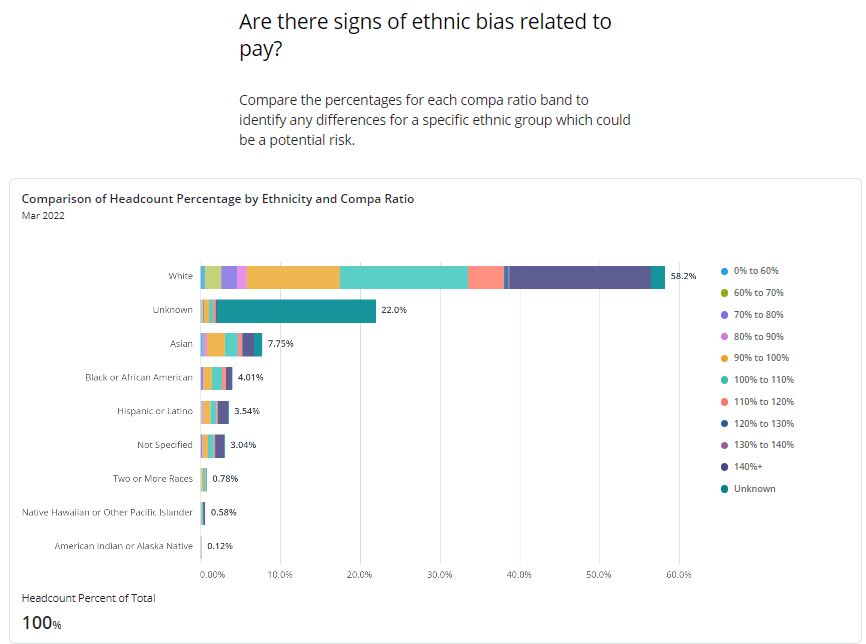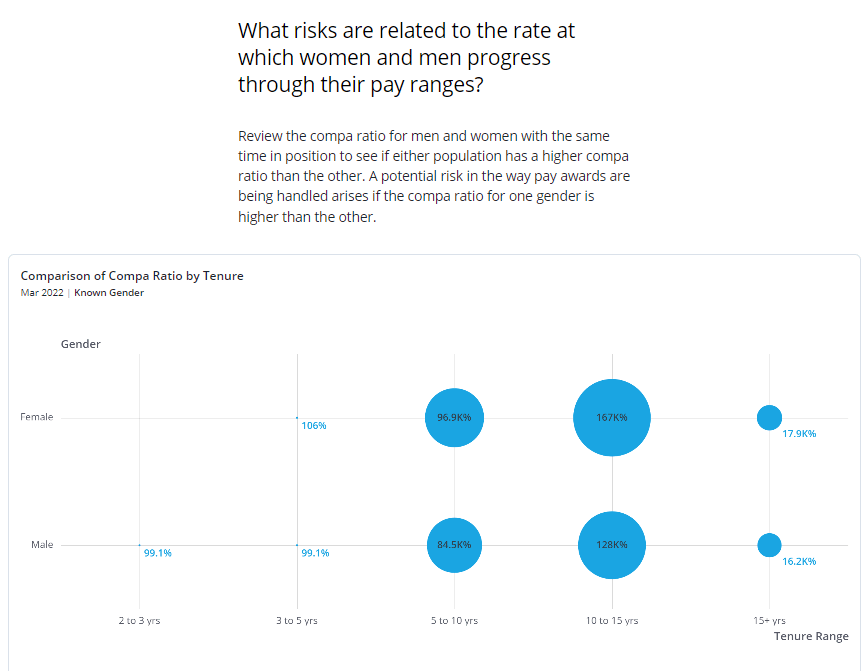Published: Sep 21, 2022Time to read: 5mins Category: Compensation
4 Ways People Analytics in Compensation Software Helps Improve Your DEI Efforts
Improving your diversity, equity, and inclusion (DEI) efforts—such as closing wage gaps—should be a top priority for every organization. After all, even the White House has a national strategy on gender equity and equality. Although the gender wage gap has shrunk overall, full-time working women still earn only 83% of their male counterparts’ salaries.
This persistent disparity prompted the National Committee on Pay Equity (NCPE) to establish Equal Pay Day. That date changes each year to symbolize how far into the current year women must work to earn what men made in the previous year. The American Association of University Women (AAUW) further recognizes pay gaps across other diverse populations with equal pay days specific to each minority group.
Staying compliant with regulations enforced by the U.S. Equal Employment Opportunity Commission (EEOC) merely scratches the surface of why your DEI goals are essential. Striving for a more inclusive and equitable workplace improves company culture and increases productivity among employees.
While it’s possible to derive important data by manually reviewing your employees’ compensation details, there are more effective ways to achieve your DEI goals. You can leverage people analytics embedded in compensation software to guide your organization toward best DEI practices. Read on to learn more.
KEEP READING | ‘Visualizations and Metrics That HR Leaders Love’
Powerful Employee Data—Straight From Your Compensation Application
The right tools can make all the difference when it comes to managing compensation for your organization. Sophisticated software applications can easily help you identify and assess potential discrepancies. The best compensation software also integrates with applications that can perform specific pay equity analyses for your organization.
Having that information readily available also gives you the opportunity to make course corrections when necessary. Here are some of the ways people analytics elevates compensation planning.
1) Compare Diversity and Performance

Software like PeopleFluent Compensation offers an array of options for viewing your employee data. With grid charts like the ones above, you can easily review employee performance according to factors such as ethnicity, gender, veteran status, and more.
These visualizations offer insights that are quick to digest, so your HR leaders can begin considering why performance might differ among groups. Your compensation tool might not be able to give you the why behind performance differences, but knowing when discrepancies exist can be the first step to finding solutions.
2) Discover Potential Biases

People analytics offers you various analysis options that help you see your compensation practices from multiple angles. These analyses allow you to look for signs of bias related to gender, ethnicity, sexual orientation, and other diversifying factors. An employee’s willingness to self-report will impact this data; however, you can still gain valuable insight into your payment and benefit policies.
In the example above, the organization compares its headcount percentage by ethnicity to compa-ratio. Nearly 60% of this organization’s headcount self-identifies as white, and the compa-ratio for over half of this population is more than 100%. These numbers greatly contrast those of the other ethnicities in the analysis.
HR and other organizational leaders might infer that there is unintentional pay bias occurring. Having such data gives them the chance to create a plan to address the concern.
READ THIS PAY TRANSPARENCY CASE STUDY | ‘Furniture Retailer Achieves Clarity and Greater Efficiency With PeopleFluent Compensation’
3) Assess Potential Risks

In addition to analyzing data, people analytics helps business leaders and HR professionals assess potential risks. For example, the way pay awards are handled can pose a risk when the compa-ratio for one group is higher than that of another group performing the same job.
In the image above, we see an organization that appears to be progressing its female employees through their careers at a higher compa-ratio than its male counterparts. This data allows the organization to review its compensation structure to address these discrepancies.
4) Address Pay Inversion and Inequity
Another benefit of employing workforce analytics with your compensation software is that you can identify instances of pay inversions and inequity—and work to make changes.
For example, sophisticated software can create a compensation cycle that looks at recommending increases for employees with a longer tenure who are being paid less than those in the same jobs with a shorter tenure. This allows you to assess any potential biases between younger employees and those with more experience.
Your people analytics can also help you spot instances where employees are being paid at higher rates than those in management positions. The quickly accessible data lets your organization address such pay inversions. Correcting pay inequities can greatly improve your overall workforce morale.
Making Data-Driven DEI Decisions
There’s a multitude of ways you can use analytics to improve your business. The first step to making improvements is having compensation software that gives you access to powerful data visualizations.
People analytics shows you the data you need to make future-forward decisions meant to improve your organization’s overall diversity and culture—and remain compliant with state and federal regulations. With improved culture and increased productivity as an added bonus, you really can’t go wrong.
DISCOVER MORE | ‘8 Data Visualizations Available With PeopleFluent Performance, Compensation, and Succession’
Leverage the Power of People Analytics in Your DEI Efforts
You can foster a culture of diversity through data-backed decisions, but don’t just take our word for it! Read our success story series, PeopleFluent Compensation: Customer Spotlight Flipbook, to see how other organizations have benefited from people analytics. Alternatively, you can see for yourself by requesting a demo today.